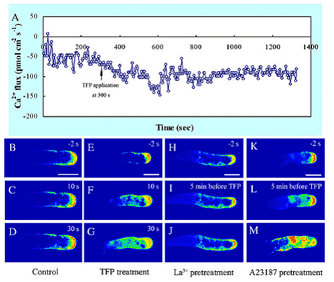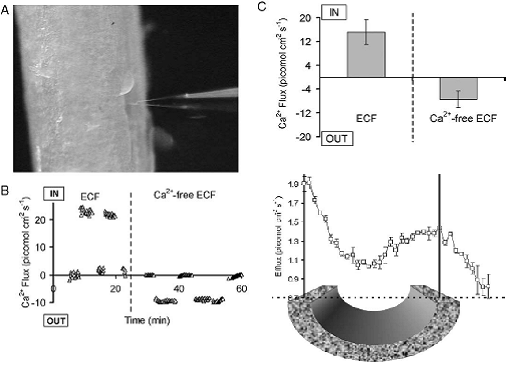The System allows for label-free and real-time monitoring of ion flux changes that happened during different biological processes, using Non-invasive Micro-test System. Real-time monitoring of ion flux offers distinct and important advantages over traditional assays. First, the avoidance of labels allows for more physiologically relevant assays which save on time, labor, and resources. Second, a comprehensive representation of entire length of the assay is possible allowing the user to make informed decisions regarding the timing of certain manipulations or treatments. Finally, the actual ion signal within an assay prior or subsequent to certain manipulations provides important information regarding the biological sample status.
NMT technique has been used extensively in the past 20 years, including plant physiology, medical science microbiological research and so on.
Plant Sciences
Plant stress physiology
Dynamic monitoring ion flux of plant sample expose to the stress environment.In this example, the protoplasts were isolated from long-term (LT) salinity stressed roots of P. euphratica and P. popularis, the flux of H+ was monitored by the NMT system in real time.From the data, compared to salt-sensitive P. popularis, salt-tolerant P.euphratica roots exhibited an increasing H+ influx. Together with Na+ and Cl- data, the mechanism of plant salinity resistance was investigated.

Plant Growth and Development
In this example, the Ca2+ flux in Picea meyeri pollen tube treated with trifluoperazine was measured.The inhibition of Ca2+ -CaM signaling rapidly induced an increase in extracellular Ca2+influx, resulting in dramatically increased cytosolic Ca2+ concentrations and ultrastructural abnormalities in organelles as the primary responses.

Zoology and Medical Science
In this example, direct real-time measurements of Ca2+ fluxes was made on metatarsal bones of weanling mice after drilling a 100-μm hole through the cortex to expose the internal bone extracellular fluid (BECF) to the bathing solution, whose composition mimicked the extracellular fluid (ECF). Influxes of Ca2+ towards the center of the cortical hole were found in the ECF and were reversed to effluxes when calcium was depleted from the ECF, mimicking a plasma demand. The timeframes of the exchanges and the stability of the Ca2+fluxes over time suggest the existence of an exchangeable calcium pool in bone.

Microbiological Research
In this example, voltage dependence of ionic currents and ion fluxes in a walled, turgor-regulating cell were measured in Neurospora crassa. The ion fluxes were measured directly and non-invasively with self-referencing ion-selective microelectrodes (Fig. 1). K+ and Cl– fluxes were larger and voltage dependent. Maximal K+ net release was observed at positive voltages, while maximal Cl- net release was observed at negative voltage (Fig.2). A possible function of the net outward K+ and Cl- fluxes is regulation of the plasma membrane potential. Total ion fluxes were 37–58% of the total ionic current density so other ions must contribute significantly to the ionic currents.


Environmental Science
Detection of harmful chemicals and biological agents in real time to protect freshwater ecosystems. In this example, the real-time effects of five environmental contaminants with differing modes of action (atrazine, cadmium chloride, pentachlorophenol, malathion, and potassium cyanide) on respiratory oxygen consumption in 2-day postfertilization fathead minnow (Pimephales promelas) eggs were studied (Fig.1). Oxygen consumption data indicated that the technique is indeed sensitive enough to reliably detect physiological alterations induced by four of the five contaminants (Fig.2). This is the first step in development of a new technique for physiologically coupled biomonitoring as a sensitive and reliable tool for the detection of environmental toxicants.


Materials Science
This example is the successful application of ion-selective micro-electrodes for mapping local activity of Mg2+ and H+ (by Non-invasive Micro-test System, NMT) as well as local ionic current density measurements (by scanning vibrating electrode technique, SVET) over the surface of Mg-based alloy in aqueous chloride-containing solution. The local concentration of Mg2+ ions dissolved due to corrosion from artificial defects and pH changes together with cathodic and anodic currents are measured by combination of two selective and one vibrating microelectrodes. Combination of these techniques in one experiment gives a powerful tool for investigation mechanisms and kinetics of electrochemical corrosion processes in micro-confined zones.


The Combination of NMT and other techniques
Combine with Fluorescence Technique

Ca2+ is an essential ion in the control of pollen germination and tube growth. In this example, Nifedipine (Nif) was used to study Ca2+functions in differential protein expression and other cellular processes in Pinus bungeana pollen tube growth. Blocking the L-type Ca2+ channel with Nif in the pollen tube membrane induced several early alterations within a short time, including a reduction of extracellular Ca2+ influx and a subsequently dramatic decrease in cytosolic free Ca2+ concentration ([Ca2+]c), concomitant with ultrastructural abnormalities and changes in the abundance of proteins involved in energy production and signaling. Secondary alterations included actin filament depolymerization, disrupted patterns of endocytosis/exocytosis, and cell wall remodeling, along with changes in the proteins involved in these processes. These results suggested that extracellular Ca2+ influx was necessary for the maintenance of the typical tip-focused [Ca2+]c gradient in the P. bungeana pollen tube.
Combine with Confocal Technique
In this example, using a new combination of methods that simultaneously monitor the extracellular flux with a Ca2+- vibrating probe, and [Ca2+]Cyt by widefield imaging, the Ca2+ influx is found to precede the [Ca2+]Cyt elevation by 40–120s. In addition, results from experiments using the Ca2+-channel inhibitor gadolinium (Gd3+) suggest that the Ca2+ influx may be necessary for sperm incorporation.

Producing Area:USA